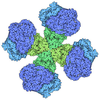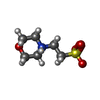+ Open data
Open data
- Basic information
Basic information
| Entry | Database: PDB / ID: 1ma3 | ||||||
|---|---|---|---|---|---|---|---|
| Title | Structure of a Sir2 enzyme bound to an acetylated p53 peptide | ||||||
 Components Components |
| ||||||
 Keywords Keywords | PROTEIN BINDING / TRANSCRIPTION / ENZYME-SUBSTRATE COMPLEX | ||||||
| Function / homology |  Function and homology information Function and homology informationprotein-malonyllysine demalonylase activity / protein-succinyllysine desuccinylase activity / protein acetyllysine N-acetyltransferase / histone deacetylase activity, NAD-dependent / negative regulation of helicase activity / Loss of function of TP53 in cancer due to loss of tetramerization ability / Regulation of TP53 Expression / signal transduction by p53 class mediator / negative regulation of G1 to G0 transition / negative regulation of glucose catabolic process to lactate via pyruvate ...protein-malonyllysine demalonylase activity / protein-succinyllysine desuccinylase activity / protein acetyllysine N-acetyltransferase / histone deacetylase activity, NAD-dependent / negative regulation of helicase activity / Loss of function of TP53 in cancer due to loss of tetramerization ability / Regulation of TP53 Expression / signal transduction by p53 class mediator / negative regulation of G1 to G0 transition / negative regulation of glucose catabolic process to lactate via pyruvate / Transcriptional activation of cell cycle inhibitor p21 / regulation of intrinsic apoptotic signaling pathway by p53 class mediator / negative regulation of pentose-phosphate shunt / ATP-dependent DNA/DNA annealing activity / Activation of NOXA and translocation to mitochondria / regulation of cell cycle G2/M phase transition / oligodendrocyte apoptotic process / negative regulation of miRNA processing / intrinsic apoptotic signaling pathway in response to hypoxia / regulation of fibroblast apoptotic process / positive regulation of thymocyte apoptotic process / oxidative stress-induced premature senescence / regulation of tissue remodeling / positive regulation of mitochondrial membrane permeability / mRNA transcription / bone marrow development / positive regulation of programmed necrotic cell death / circadian behavior / T cell proliferation involved in immune response / regulation of mitochondrial membrane permeability involved in apoptotic process / germ cell nucleus / RUNX3 regulates CDKN1A transcription / homolactic fermentation / TP53 Regulates Transcription of Death Receptors and Ligands / Activation of PUMA and translocation to mitochondria / TP53 regulates transcription of additional cell cycle genes whose exact role in the p53 pathway remain uncertain / histone deacetylase regulator activity / regulation of DNA damage response, signal transduction by p53 class mediator / negative regulation of glial cell proliferation / Regulation of TP53 Activity through Association with Co-factors / negative regulation of neuroblast proliferation / mitochondrial DNA repair / T cell lineage commitment / Formation of Senescence-Associated Heterochromatin Foci (SAHF) / ER overload response / thymocyte apoptotic process / B cell lineage commitment / TP53 Regulates Transcription of Caspase Activators and Caspases / entrainment of circadian clock by photoperiod / cardiac septum morphogenesis / negative regulation of mitophagy / negative regulation of DNA replication / Zygotic genome activation (ZGA) / Association of TriC/CCT with target proteins during biosynthesis / PI5P Regulates TP53 Acetylation / TP53 Regulates Transcription of Genes Involved in Cytochrome C Release / necroptotic process / positive regulation of release of cytochrome c from mitochondria / negative regulation of telomere maintenance via telomerase / SUMOylation of transcription factors / TP53 regulates transcription of several additional cell death genes whose specific roles in p53-dependent apoptosis remain uncertain / TFIID-class transcription factor complex binding / intrinsic apoptotic signaling pathway by p53 class mediator / rRNA transcription / negative regulation of reactive oxygen species metabolic process / Transcriptional Regulation by VENTX / cellular response to UV-C / replicative senescence / viral process / general transcription initiation factor binding / intrinsic apoptotic signaling pathway in response to endoplasmic reticulum stress / NAD+ binding / positive regulation of RNA polymerase II transcription preinitiation complex assembly / cellular response to actinomycin D / neuroblast proliferation / intrinsic apoptotic signaling pathway in response to DNA damage by p53 class mediator / positive regulation of execution phase of apoptosis / Pyroptosis / hematopoietic stem cell differentiation / embryonic organ development / response to X-ray / chromosome organization / type II interferon-mediated signaling pathway / somitogenesis / TP53 Regulates Transcription of Genes Involved in G1 Cell Cycle Arrest / hematopoietic progenitor cell differentiation / negative regulation of fibroblast proliferation / positive regulation of cardiac muscle cell apoptotic process / core promoter sequence-specific DNA binding / glial cell proliferation / negative regulation of stem cell proliferation / cellular response to glucose starvation / cis-regulatory region sequence-specific DNA binding / mitophagy / Regulation of TP53 Activity through Acetylation / positive regulation of intrinsic apoptotic signaling pathway / response to salt stress / 14-3-3 protein binding / mitotic G1 DNA damage checkpoint signaling / negative regulation of proteolysis Similarity search - Function | ||||||
| Biological species |   Archaeoglobus fulgidus (archaea) Archaeoglobus fulgidus (archaea) | ||||||
| Method |  X-RAY DIFFRACTION / X-RAY DIFFRACTION /  SYNCHROTRON / SYNCHROTRON /  MOLECULAR REPLACEMENT / Resolution: 2 Å MOLECULAR REPLACEMENT / Resolution: 2 Å | ||||||
 Authors Authors | Avalos, J.L. / Celic, I. / Muhammad, S. / Cosgrove, M.S. / Boeke, J.D. / Wolberger, C. | ||||||
 Citation Citation |  Journal: Mol.Cell / Year: 2002 Journal: Mol.Cell / Year: 2002Title: Structure of a Sir2 enzyme bound to an acetylated p53 peptide Authors: Avalos, J.L. / Celic, I. / Muhammad, S. / Cosgrove, M.S. / Boeke, J.D. / Wolberger, C. | ||||||
| History |
|
- Structure visualization
Structure visualization
| Structure viewer | Molecule:  Molmil Molmil Jmol/JSmol Jmol/JSmol |
|---|
- Downloads & links
Downloads & links
- Download
Download
| PDBx/mmCIF format |  1ma3.cif.gz 1ma3.cif.gz | 67 KB | Display |  PDBx/mmCIF format PDBx/mmCIF format |
|---|---|---|---|---|
| PDB format |  pdb1ma3.ent.gz pdb1ma3.ent.gz | 47.9 KB | Display |  PDB format PDB format |
| PDBx/mmJSON format |  1ma3.json.gz 1ma3.json.gz | Tree view |  PDBx/mmJSON format PDBx/mmJSON format | |
| Others |  Other downloads Other downloads |
-Validation report
| Summary document |  1ma3_validation.pdf.gz 1ma3_validation.pdf.gz | 453.1 KB | Display |  wwPDB validaton report wwPDB validaton report |
|---|---|---|---|---|
| Full document |  1ma3_full_validation.pdf.gz 1ma3_full_validation.pdf.gz | 456.1 KB | Display | |
| Data in XML |  1ma3_validation.xml.gz 1ma3_validation.xml.gz | 14.8 KB | Display | |
| Data in CIF |  1ma3_validation.cif.gz 1ma3_validation.cif.gz | 19.9 KB | Display | |
| Arichive directory |  https://data.pdbj.org/pub/pdb/validation_reports/ma/1ma3 https://data.pdbj.org/pub/pdb/validation_reports/ma/1ma3 ftp://data.pdbj.org/pub/pdb/validation_reports/ma/1ma3 ftp://data.pdbj.org/pub/pdb/validation_reports/ma/1ma3 | HTTPS FTP |
-Related structure data
| Related structure data | 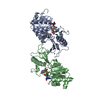 1iciS S: Starting model for refinement |
|---|---|
| Similar structure data |
- Links
Links
- Assembly
Assembly
| Deposited unit | 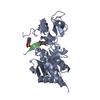
| ||||||||
|---|---|---|---|---|---|---|---|---|---|
| 1 |
| ||||||||
| Unit cell |
|
- Components
Components
| #1: Protein | Mass: 28537.006 Da / Num. of mol.: 1 Source method: isolated from a genetically manipulated source Source: (gene. exp.)   Archaeoglobus fulgidus (archaea) / Gene: SIR2-Af2 / Plasmid: pET11A / Production host: Archaeoglobus fulgidus (archaea) / Gene: SIR2-Af2 / Plasmid: pET11A / Production host:  |
|---|---|
| #2: Protein/peptide | Mass: 2139.521 Da / Num. of mol.: 1 / Fragment: Regulatory C-terminal tail (residues 372-389) / Source method: obtained synthetically Details: The sequence of the protein is naturally found in Homo sapiens. The protein is an Fmoc synthesized peptide. References: UniProt: P04637 |
| #3: Chemical | ChemComp-ZN / |
| #4: Chemical | ChemComp-MES / |
| #5: Water | ChemComp-HOH / |
| Has protein modification | Y |
-Experimental details
-Experiment
| Experiment | Method:  X-RAY DIFFRACTION / Number of used crystals: 1 X-RAY DIFFRACTION / Number of used crystals: 1 |
|---|
- Sample preparation
Sample preparation
| Crystal | Density Matthews: 1.98 Å3/Da / Density % sol: 37.79 % | |||||||||||||||||||||||||||||||||||||||||||||||||
|---|---|---|---|---|---|---|---|---|---|---|---|---|---|---|---|---|---|---|---|---|---|---|---|---|---|---|---|---|---|---|---|---|---|---|---|---|---|---|---|---|---|---|---|---|---|---|---|---|---|---|
| Crystal grow | Temperature: 291 K / Method: vapor diffusion, hanging drop / pH: 5.5 Details: PEG 8000, PEG 1000 and Sodium Chloride, pH 5.5, VAPOR DIFFUSION, HANGING DROP, temperature 291K | |||||||||||||||||||||||||||||||||||||||||||||||||
| Crystal grow | *PLUS Temperature: 20 ℃ | |||||||||||||||||||||||||||||||||||||||||||||||||
| Components of the solutions | *PLUS
|
-Data collection
| Diffraction | Mean temperature: 93 K |
|---|---|
| Diffraction source | Source:  SYNCHROTRON / Site: SYNCHROTRON / Site:  NSLS NSLS  / Beamline: X25 / Wavelength: 1.1 Å / Beamline: X25 / Wavelength: 1.1 Å |
| Detector | Type: BRANDEIS - B4 / Detector: CCD / Date: Jul 20, 2001 |
| Radiation | Monochromator: Two crystal non-dispersive monochromator / Protocol: SINGLE WAVELENGTH / Monochromatic (M) / Laue (L): M / Scattering type: x-ray |
| Radiation wavelength | Wavelength: 1.1 Å / Relative weight: 1 |
| Reflection | Resolution: 2→50 Å / Num. all: 15490 / Num. obs: 15490 / % possible obs: 97.6 % / Observed criterion σ(I): -3 / Redundancy: 5.1 % / Biso Wilson estimate: 17.5 Å2 / Rmerge(I) obs: 0.101 / Rsym value: 0.101 / Net I/σ(I): 11.8 |
| Reflection shell | Highest resolution: 2 Å / Redundancy: 3.1 % / Rmerge(I) obs: 0.322 / Mean I/σ(I) obs: 4.2 / Num. unique all: 1414 / Rsym value: 0.323 / % possible all: 92.4 |
| Reflection | *PLUS Num. measured all: 79201 / Rmerge(I) obs: 0.113 |
| Reflection shell | *PLUS % possible obs: 92.4 % / Num. unique obs: 1414 / Num. measured obs: 4350 / Rmerge(I) obs: 0.342 |
- Processing
Processing
| Software |
| |||||||||||||||||||||||||
|---|---|---|---|---|---|---|---|---|---|---|---|---|---|---|---|---|---|---|---|---|---|---|---|---|---|---|
| Refinement | Method to determine structure:  MOLECULAR REPLACEMENT MOLECULAR REPLACEMENTStarting model: PDB entry 1ICI Resolution: 2→50 Å / Isotropic thermal model: isotropic / Cross valid method: THROUGHOUT / σ(F): 0 / Stereochemistry target values: Engh & Huber
| |||||||||||||||||||||||||
| Displacement parameters | Biso mean: 21.2 Å2 | |||||||||||||||||||||||||
| Refine analyze |
| |||||||||||||||||||||||||
| Refinement step | Cycle: LAST / Resolution: 2→50 Å
| |||||||||||||||||||||||||
| Refine LS restraints |
| |||||||||||||||||||||||||
| LS refinement shell | Highest resolution: 2 Å / Rfactor Rfree error: 0.05
| |||||||||||||||||||||||||
| Refinement | *PLUS % reflection Rfree: 5.17 % / Rfactor obs: 0.211 / Rfactor Rfree: 0.254 / Rfactor Rwork: 0.209 | |||||||||||||||||||||||||
| Solvent computation | *PLUS | |||||||||||||||||||||||||
| Displacement parameters | *PLUS | |||||||||||||||||||||||||
| Refine LS restraints | *PLUS
| |||||||||||||||||||||||||
| LS refinement shell | *PLUS Rfactor Rfree: 0.254 / Rfactor Rwork: 0.209 |
 Movie
Movie Controller
Controller






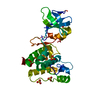

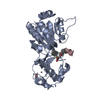
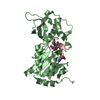
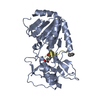
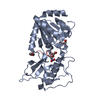
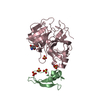
 PDBj
PDBj




